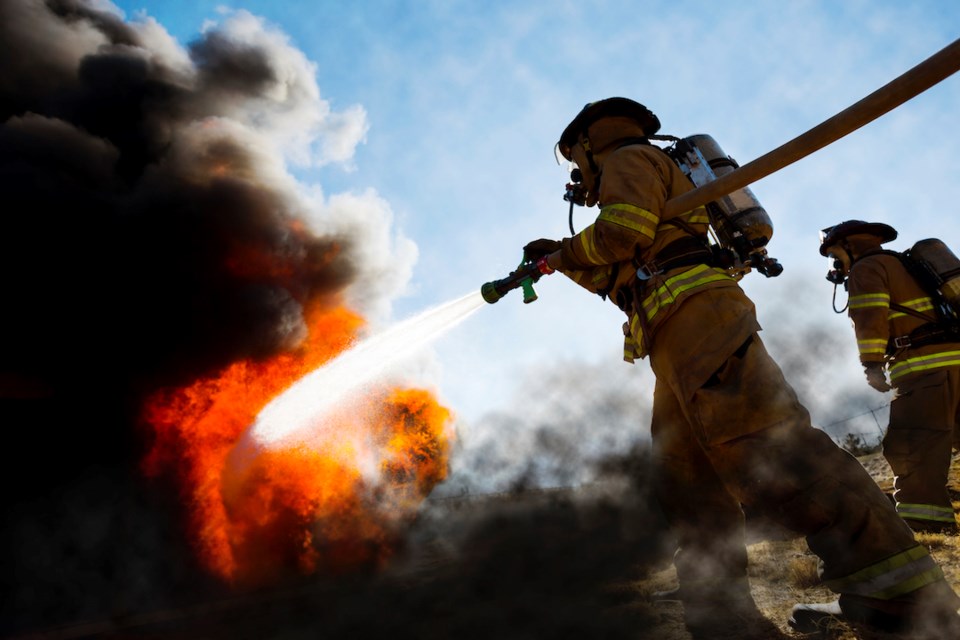As climate change increases fire risk, how can local residents outside of fire protection districts receive or create their own fire protection? The short answer? The Sunshine Coast Regional District is not quite sure, but directors say it needs to start with community action.
Provincial regulations, on-the-ground practicalities and community will clashed (in bureaucratic mundanity) July 10 as directors received for information, options for those within its district but outside its protection.
Despite the Sunshine Coast’s six fire departments, swaths of the Coast, including in the Langdale-Port Mellon and Sakinaw Lake areas and the islands (Nelson, Thormanby, Keats, among others), are without fire protection.
While fire departments are allowed to respond to fires outside their jurisdiction if there’s an immediate threat to life, structure fires that do not threaten life are outside their purview.
The topic is particularly top of mind for West Howe Sound director Kate Stamford, whose constituents in the Langdale-Port Mellon area have been petitioning for the expansion of the Gibsons and District Volunteer Fire Department’s boundary, and where a home burned in March and firefighters were forced to stand down.
The report presented demonstrated the dearth of programs, outside of wildfire, for people in rural areas, Stamford shared. "Forty-five per cent of the province is not in a specific fire service, and those are the rural areas. But it doesn't mean that they should just be left unorganized."
“There's very little, if anything, for rural communities that are looking for structural fire support,” said Stamford. She said the SCRD, with its emergency planning mandate, has a duty of care to the residents of the unprotected areas and pushed for this discussion to continue politically.
Gibsons and District Volunteer Fire Department Chief Rob Michael laid out some options for fire protection in those areas. Beyond the FireSmart program (which is very active on the Coast and particularly in these rural areas), the community-led fire brigades caught the interest of directors –– though how to go about supporting them wasn’t clear.
Brigades are outside the local government sphere, may operate independently and vary in structure, capacity and scope, said Michael’s report. “They may focus on initial response efforts, fire prevention or support during wildfire events, depending on local needs and available resources.” Brigades are held to provincial training standards.
However, the SCRD does not fund or oversee any brigades, said Michael.
For Elphinstone director Donna McMahon, the province deciding not to create new improvement districts, which fulfill basic services outside of incorporated areas and local government, has left a “real gap.”
“An improvement district has far more powers than a fire brigade,” said McMahon. “They have the authority to tax, for instance, to support the service. And this leaves communities in a kind of state of limbo.”
Ideas directors threw around included having fire brigades to look after smaller issues with the full-fledged departments backing up bigger situations (similar to the mutual service agreements among the Coast departments), donating old equipment to brigades and offering training officer time to help train up brigade members.
But ultimately, directors agreed, it comes down to communities.
Roberts Creek director Kelly Backs, a former member of the xwesam-Roberts Creek Volunteer Fire Department, acknowledged both the liability and urged community action.
“In the old days, the firefighters shared bunker gear. Somebody got the coat, somebody else got the pants. And then they started coming down with cancers that were presumed to be caused by their actions within houses,” said Backs. “And so the world is run by insurance agents, but sometimes it's a balance.”
But fire protection has to start on the ground, said Backs. “There are people within every community that have training, that are former, retired or have spent some time in the fire service, and those are the individuals we have to lean to.
"Without a dedicated group of individuals within the community, there will be no fire protection," said Backs. “Once they've organized themselves, then as a government, we may be able to step in and aid them in their endeavour.”
Where does that leave residents? No decisions came out of the meeting. As part of next year’s budget process, the SCRD will look at doing a feasibility study for the expansion of the Gibsons fire department’s coverage area.
During question period Ian Winn, one of the movers and shakers trying to expand the Gibsons fire district boundary, told directors of the overwhelming support the initiative has in their area. He said, they’re not looking for an answer of “no” they’re looking for an answer of “this is how it could happen.”
“The community is asking for a reasonable process to go through this, and an expectation that there is reasonable level of service that can be provided,” said Winn.



